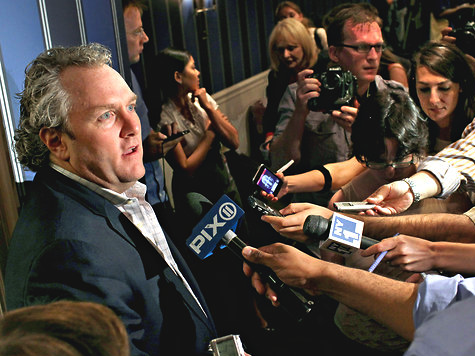Buzzfeed’s McKay Coppins claims that “conservative media lost the election.” He echoes an emerging theme in the mainstream media and the Republican establishment, arguing that conservative outlets were wrong about the polls, and that we failed to make our narrative about Obama’s radicalism “stick.” Establishment Democrats said similar things about the left media after 2004–and there is much we can learn from the left’s response.
True, conservatives did not anticipate the electorate Obama turned out. Yet a bit of perspective is in order. In 2002, Markos Moulitsas defied polls and predicted a win for Democrats (incorrectly) because they “are masters of GOTV.” (Now he mocks us for a similar argument about GOP turnout in 2012.) In 2004, the left from Al Franken to Michael Moore predicted victory. In 2006, only 6 of the 61 candidates Kos backed won their races.
But Coppins is wrong about the conservative narrative about Obama’s radicalism. It did stick, because it is true, and was confirmed by Obama’s behavior on the campaign trail (“You didn’t build that!”). The trouble was that the left’s narrative about Mitt Romney stuck, too, and was amplified by a still-powerful mainstream media that, moreover, did its best to ignore the economy and to assist Obama’s cover-up of the Benghazi attacks.
Today’s debate among Republicans about the role of conservative new media and the Tea Party grass roots echoes the debate among Democrats after John Kerry’s defeat in 2004. The centrists of the (now defunct) Democratic Leadership Council argued: “We need to be the party of Harry Truman and John Kennedy, not Michael Moore.” In contrast, the party’s left wing blamed Kerry’s “wishy-washy” opposition to the Iraq War.
The left won, as Hamm notes in The New Blue Media, after the “netroots” set out to achieve “a hostile takeover of the Democratic Party,” which set the stage for the rise of John Edwards and Barack Obama in the 2008 primaries. The left also continued to wage aggressive cultural battles and media campaigns that built on the earlier efforts of agitprop activists like Moore and satirists such as Jon Stewart and Stephen Colbert.
Tactically, Hamm observes, the left’s “didactic wing”–including Moore and the failed Air America radio network–who focused on fighting George W. Bush were less successful than the techies and satirists who focused on changing the Democratic Party and the popular culture. The latter backed new leaders who sided with the “Democratic wing of the Democratic Party,” as Howard Dean often said, en route to victory in 2006.
Today, conservatives are demanding a similar overhaul of the Republican Party, calling for the removal of the “consultant class” in Washington D.C. that many blame for the botched get-out-the-vote effort of the Romney campaign, and for renewed attention to pop culture, which the GOP has long neglected. That takeover already began in 2010 with the rise of the Tea Party, which is determined to replace a complacent GOP establishment.
Before fully reprising the left’s post-2004 effort, however, conservatives should consider that the political situation today is different. Blue Dog Democrats and moderate Republicans have faded. Capitol Hill is not just divided between the two parties, but also two opposition movements: the antiwar base that gave Democrats control of the Senate in 2006, and the Tea Party that put Republicans in charge of the House in 2010.
At the urging of both sides’ grass roots, Americans voted not just for divided government, but against government–albeit against different aspects of it. And where the task of governing cannot be deferred, at the state level, the country is split: “blue” states like California and Illinois are more blue, while “red” states like Tennessee are even more red, while more states that voted for Obama remained Republican than the reverse.
America is in the midst of an experiment as to whether the heavily-indebted, big-union, socially liberal blue states controlled by Democrats will prove more successful than the tight-budgeted, right-to-work, traditional-values red states controlled by Republicans. So far, the red states are winning, as taxpayers vote with their feet and investors vote with their dollars, leaving California for Texas, Washington for South Carolina.
That suggests a new strategy for conservative media, beyond fighting the media and the GOP establishment: highlight blue state failures and red state achievements. Voters who chose Obama’s path should be confronted with the results. And conservative policy success should be flung at the feet of the mainstream media every day. That will allow conservative media to transcend the politics of gridlock with a positive, governing vision.

COMMENTS
Please let us know if you're having issues with commenting.